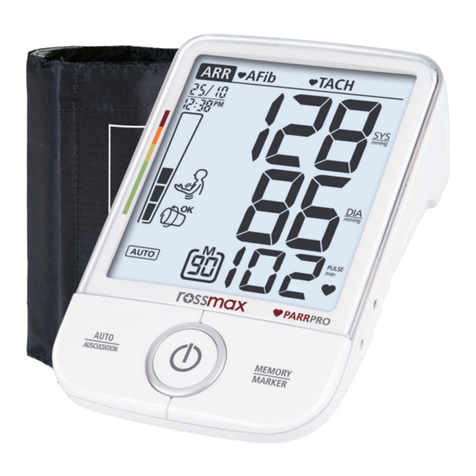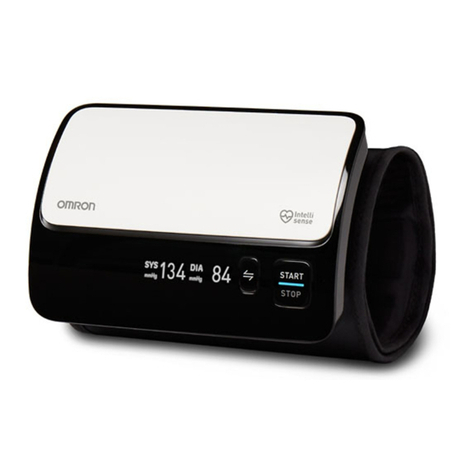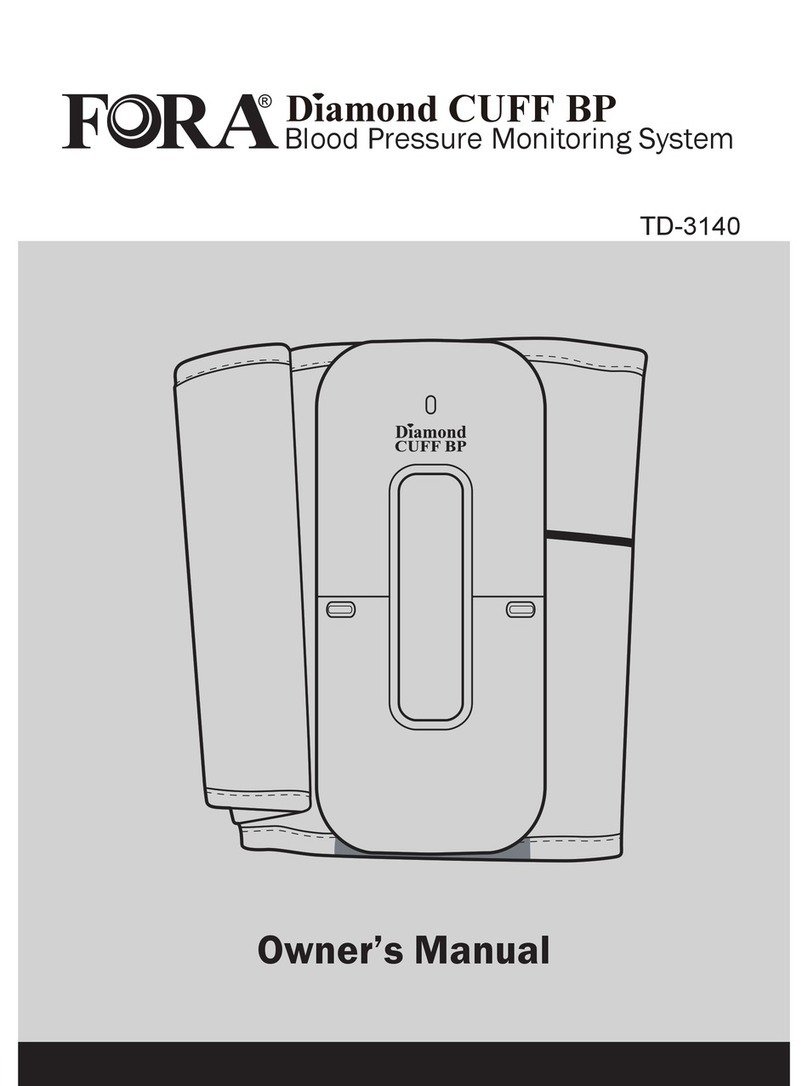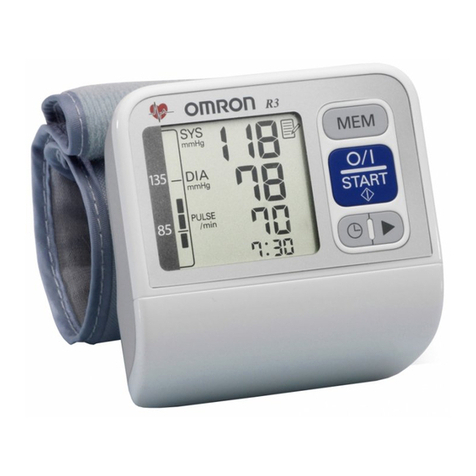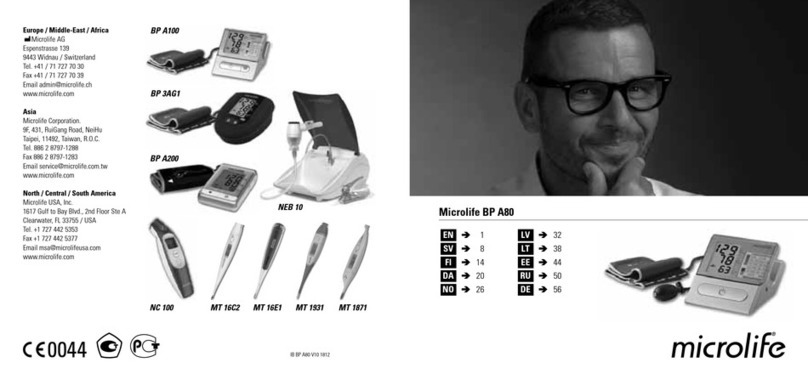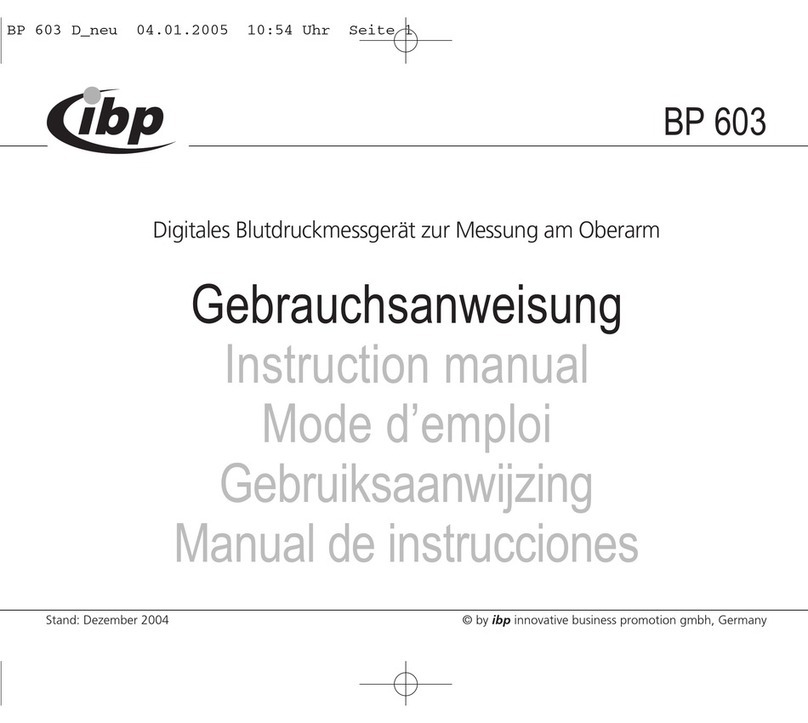Health & Life HL858CG User manual

1
Instruction Manual
Automatic
Upper Arm Blood Pressure Monitor
Model No. HL858CG

2
Table of Contents
Medical Disclaimer……………………………………………………………………………03
Intended Use………………………………………………………………………………..…03
About Blood Pressure………………………………………………………………………04
Measurement Method…………....……………………………………………………06
Accuracy……………………….…………………………………………………………………07
Precautions………………….…………………………………………………….…………….. 08
Device Overview……………………………………………………………………………….10
Symbol Definitions………………………………………………………………………….13
Features………………………………………………………………………………………….14
Installing Batteries………………………………………………………………………….20
Using the AC Adapter………………………………………………………………………21
Applying the Cuff…………………………………………………………………………….22
Measurement Procedure………….…………………………………………………….23
Bluetooth Transmission………………………………………………………………………30
Memory Function…………………………………………………………………………….32
Storage and Maintenance……………………………………………………………….35
Troubleshooting……………………………………………………………………………….36
Warranty & Recalibration……………….……………………………………………….37
Specifications………………………………………………………………………………….38
Note………………………………………………………………………………………….…….40
Appendix…………………………………………………………………………………….…….42
Blood Pressure Diary……………….……………………………………………….…….44

3
Medical Disclaimer
This manual and product are not meant as a substitute for advice
provided by your doctor.
You are not to use the information contained herein, or this product for
diagnosing or treating a health problem or prescribing any medication.
If you have or suspect that you have a medical problem, promptly
consult your healthcare provider.
Intended Use
HL858CG automatically measures human’s Systolic, Diastolic blood
pressure and heart rate by using the oscillometric method during
inflation. All values can be read out in one LCD panel. Measurement
position is at human being’s upper arm. The intended use of this
over-the-counter device is for adults aged 18 years and older with arm
circumference ranging from 9 inches to 17 inches (approx.23 cm to 43
cm) and for home use.
HL858CG detects the appearance of irregular heartbeats during
measurement; an indicated symbol will appear with measuring
reading. And the Risk Category Indicator will show the information
with the readings on the screen for the user tracking their blood
pressure level.
Besides, the device features a built-in "Bluetooth Data Transmission"
function, which enables the device automatically transmit measuring
results to paired Bluetooth-enabled device. Also, users could simply
synchronize the current date and time, and check the battery status of
blood pressure monitor by means of DailyChek®application software
with the paired Bluetooth-enabled device.

4
About Blood Pressure
1. What is blood pressure?
Blood pressure is the measurement of the force of blood pushing
against the walls of the arteries. Arterial blood pressure is
constantly fluctuating during the course of the cardiac cycle. The
highest pressure in the cycle is called the systolic blood pressure,
and represents the pressure in the artery when the heart is beating.
The lowest pressure is the diastolic blood pressure, and represents
the pressure in the artery when the heart is at rest. Both the systolic
and the diastolic pressure are necessary for a physician to evaluate
the status of a patient's blood pressure.
Many factors such as physical activity, anxiety or the time of day,
can influence your blood pressure. Blood pressure is typically low in
the mornings and increases from the afternoon to the evening. It is
on average lower in the summer and higher in the winter.
2. Why is it useful to measure blood pressure
at home?
Having one's blood pressure measured by a doctor in a hospital or a
clinic, is often associated with an event called “White Coat
Hypertension” where the patient becomes nervous or anxious, thus
raising his blood pressure. There are also numerous other factors
that might cause your blood pressure to be raised at a specific time
of day. This is why medical physician recommend home monitoring
as it is important to get readings of blood pressure during different
times of the day to really get an idea of your real blood pressure.
Medical physicians generally recommend the “Rule of 3”, where you
are encouraged to take your blood pressure three times in a row (at
3 ~ 5 minute interval), three times a day for three days. After three
days you can average all the results and this will give you an
accurate idea of what your blood pressure really is.

5
About Blood Pressure
A. Standards for assessment of high or low blood pressure
without regard to age, have been established by the WHO,
and classifications adapted from JNC7:
WHO: World Health Organization
JNC 7: The Seventh Report of the Joint National Committee on
Prevention, Detection, Evaluation, and Treatment of High Blood
Pressure. NIH Publication No.04-5230 August 2004
However the above chart is not exact for classification of blood
pressure and it's intended to be used as a guide in
understanding non-invasive blood pressure measurements.
Please consult with your physician for proper diagnosis.
B. Variations in blood pressure:
Individual blood pressures vary greatly both on a daily and a
seasonal basis. These variations are even more pronounced in
hyper tense patients. Normally the blood pressure rises while at
work and is at its lowest during sleeping period.
(hyper tense: means a person who has high blood
pressure symptom.)
The graph below illustrated the
variations in blood pressure over a
whole day with measurement taken
every five minutes.
The thick line represents sleep. The
rise in blood pressure at 4 PM (A in
the graph) and 12 PM (B in the graph) correspond to an attack of
pain.

6
Measurement Method
HL858CG Automatic Upper Arm Blood Pressure Monitor measures
blood pressure and heart rate by oscillometric method, meaning the
fluctuations in pressure are measured. Once the cuff is wrapped
around your upper arm, just turn on the monitor and inflation
automatically starts. The inflation of the cuff creates pressure around
the arteries inside upper arm.
Within the cuff is a gauge which senses the fluctuations (oscillations)
in pressure. The fluctuation measured represents the degree of
intensity that your arteries contracting with each heart beat, and also
a result of the pressure that the cuff has placed on the upper arm. The
monitor measures these contractions and converts the information to
a digital value. This is the result displayed on the monitor screen.
Once the measurement is complete, the cuff will automatically deflate.
Note!
* The patient is an intended operator.
*Theappliedpartisthe cuff.

7
Accuracy
HL858CG Automatic Upper Arm Blood Pressure Monitor has been
clinically tested against a scientific device called mercury
sphygmomanometer, considered the gold standard in blood pressure
measurement.
All HL858CG Automatic Upper Arm Blood Pressure Monitors have
performed equivalent to measurements taken with this scientific
device and are within the accuracy limits prescribed by the American
National Standard for Electronic or Automated Sphygmomanometers.
The SPHYGMOMANOMETER was clinically investigated according to
the requirements of ISO 81060-2:2013.
*We su
gg
est our users have their blood pressure monitor
checked every 2 years. This operation should only be
performed by Manufacturer or by authorized representatives.

8
Precautions
* Do not use this manual and product as a substitute for advice,
diagnosing or treating a health problem or prescribing any
medication by your doctor. If you have a medical problem,
promptly consult your healthcare provider.
* Read the Instruction Manual thoroughly before measuring and
keep it at hand for your reference at any time.
* This device uses the oscillometric method to measure systolic
and diastolic blood pressure as well as your heart rate. It’s
recommended for use by people over the age of 18 and not to be
used on infant or children.
* The device is designed for home use and not suitable for clinical
use.
* This monitor is not intended for use in the MR environment.
Do not take a measurement in a low (less than 41℉/5 )℃and high
(more than 104 /℉40 )℃temperature, nor in a place outside
humidity ranges (15 % ~ 93 % R.H.), and altitude ranges (700 ~
1060 hPa), or you may get inaccurate readings.
Wait 30 ~ 45 minutes before measurement if you’ve just consumed
caffeinated beverages or smoked cigarettes.
Rest at least 5 ~ 10 minutes before taking a measurement.
To allow your blood vessels to return to the condition prior to taking
the measurement, please wait at least 3 ~ 5 minutes in between
measurements. You may need to adjust the wait time according to
your personal physiological situation.
We recommend you using the same arm (preferably the left arm)
and measuring around the same time each day.
Sit down comfortably and place your elbow on the table with your
feet flat on the floor, and back supported. Please do not cross your
legs during measurements.
Keep the cuff at heart level. Relax your hand with the palm facing
up.
Perform measurements in a quiet and relaxed environment at room
temperature.
Do not move or shake the device during a measurement. Please
keep quiet and do not talk during measurements.
This product is not suitable for:
Pregnant women
People with arrhythmias
Undergoing intravenous injection on any limb
Currently in a dialysis treatment
In pre-eclampsia condition

9
Precautions
For those who have had mastectomy surgery (especially lymph
nodes removed), it’s recommend take a measurement on the
unaffected side.
When used among medical electronic equipments on the same limb,
pressurization of the cuff may cause temporarily malfunction to
other devices.
Keep in mind that blood pressure naturally varies from time to time
throughout the day and is affected by lots of different factors such
as stress, eating, smoking, alcohol consumption, medication, and
physical activity, etc.
Normally the blood pressure rises while at work and is at its lowest
during sleeping period.
Blood pressure measurements should be interpreted by a physician
or a trained health professional who is familiar with your medical
history. Using the unit and recording the results regularly for your
physician to interpret, you will keep your physician informed of the
continuing changes in your blood pressure.
If you have one of the circulatory problems as arteriosclerosis,
diabetes, liver disease, kidney disease, severe hypertension,
peripheral circulation……, please consult your healthcare
professional before using the device.
Blood pressure measurements determined with this device are
equivalent to those obtained by a trained observer using the
cuff/stethoscope auscultation method and are within the accuracy
limits prescribed by the American National Standard for Manual,
electronic, or Automated Sphygmomanometers.
*Attention
!
1. Do not use the device on infants, children, or those who cannot express their
own intention.
2. The device is equipped with sensitive electronic components. While measuring,
avoid strong electrical or electromagnetic fields, e.g. mobile phones,
microwave ovens, etc; or it may lead to temporary reading error or inaccuracy.
3. To avoid accidental strangulation, keep this product away from children and do
not drape tube around neck.
4. Consider the electromagnetic compatibility of the device (ex. power
disturbance, radio frequency interference etc.) Please use it indoor only.
5. Over high frequency measurements may result in blood flow interference,
which is likely to cause uncomfortable sensations, such as partial subcutaneous
hemorrhage, or temporary numbness to your arm. In general, these symptoms
should not last long. However, if you do not recover in time, please seek your
medical physicians for help.

10
Device Overview
Part names and product components
AA
(LR6) (1.5V)
ALKALINE BATTERY X 4
START / STOP
Button
ARM CUFF WITH TUBE
BLUETOOTH
Button
LCD Display
Battery Cover
(located on bottom of unit)
MEMORY Button
USER-SELECT
Button

11
Device Overview
Right side view
*Caution
!
Substitution of a component different from that supplied might result in measurement error.
5.99V 2A AC Adapter
DC JACK
TRIPLE-CHECK
(MULTI-READ)
FUNCTION SWITCH
REST ASSURE
MODE SWITCH
DATE/TIME button
SET button
AM/PM button
Back view

12
Device Overview
Unit display
Irregular Heartbeat
Detector
Risk Category Indicator
Low Battery Symbol
Error Symbol
Bluetooth Symbol
Rest Assure Mode Symbol
Triple-Check (Multi-Read)
Function Symbol
AM/PM Avera
g
e S
y
mbol
User Symbol
Pulse
Symbol
Heart Rate
Systolic Rate
Diastolic Rate
Display average of
last 3 readings
Date: MM/DD/YY
Time: hour/minute
with PM icon

13
Symbol Definitions
SYMBOLS Definitions
Low Battery Symbol
This symbol appears when the battery power is extremely low or
the polarity reverses.
We suggest you replace all batteries with new ones, and make
sure the +/- polarities are properly positioned.
Error Symbol: Error display.
Pulse Symbol Once pulse is detected, the symbol flashes with each pulse beat.
Risk Category Indicator
Compares readings against blood pressure guidelines. See next
page for more information.
Triple-Check (Multi-Read) Function Symbol:
A
ppears when
Triple-Check (Multi-Read) function is turned On.
Average Symbol: Displayed when viewing a Triple-Check
average.
REST
Rest Assure Mode Symbol:
1. Rest mode on: The REST symbol will appear on monitor, that
countdowns for 5 minutes before starting single
measurement.
2. Triple check mode on: The REST symbol will flash among 3
measurements during countdown.
Bluetooth Symbol
Under Bluetooth Data Transmission / Link Mode, LCD displays this
symbol.
Triple-Check (Multi-Read) Function Result: Indicates which
measurement is being taken, or which measurement is being
viewed from a Triple-Check (Multi-Read) average reading.
Memory Average:
Display average of last 3 readings.
AM/PM Averaging:
Indicates the reading being displayed is an
average from the last 3 morning or last 3 evening
measurements.
User 1 User 1: Appears when the monitor is operated by User 1.
User 2 User 2: Appears when the monitor is operated by User 2.
Irregular Heartbeat
Detector
This symbol appears when the user was talking, moving,
shaking, or an irregular heart beat was detected during
measurements.
Our suggestion:
Please do not talk or move during measurements.
Repeat the measurement after resting for at least 5 minutes, and
restart your measurement while sitting down comfortably and
quietly.

14
Risk Category Indicator
This device is equipped with Risk Category Indicator which classifies your
blood pressure measurements into four stages (Normal,
Pre-hypertension, Stage 1 Hypertension to Stage 2 Hypertension) based
on the blood pressure standards established by the U.S. Department of
Health and Human Services and the National Institutes of Health. The
indicator symbols are defined as following classifications:
You may use the function to effectively track your blood pressure. Yet
the above standards and classifications are general guidelines for your
reference as an individual’s blood pressure varies among different
people, age groups, etc. It is important that you consult with your
physician to know your normal blood pressure range as well as the point
at which you will be considered at risk.
Features
Normal Pre-hypertension Stage 1
hypertension
Stage 2
hypertension

15
Features
For adults 18 and older who are not on medicine for high blood
pressure, are not having a short-term serious illness, and do not
have other conditions, such as diabetes and kidney disease. To
determine category of risk when systolic and diastolic readings fall
into two areas, use the higher of the two numbers for classification.
There is an exception to the above definition of high blood pressure
for people with diabetes and chronic kidney disease. A blood
pressure of 130/80 mmHg or higher is considered high blood
pressure for those individuals.
*Note !
The above table is not exact for classification of blood pressure and it's
intended to be used as a guide in understanding non-invasive blood
pressure measurements.
Usually this is not a cause for concern; however we recommend you consult
with your physician for proper diagnosis or seek medical advice. Please note
that the device does not appropriate to diagnose hypertension, and it is only
for user reference on blood pressure monitoring.

16
Features
Rest Assure Function
Before measurement, it is suggested that you sit quietly for 5 minutes before
measurement as measurements taken in a relaxed state according to JNC7
report to have a greater accuracy.
HL858CG provides users a helpful countdown function (REST ASSURE on/off
switch) for 5 minutes before the measurement that helps users to get
accurate results. To turn this feature OFF, slide the switch on the back to the
OFF position.
JNC7: The Seventh Report of the Joint National Committee on
Prevention, Detection, Evaluation, and Treatment of High Blood
Pressure. NIH Publication No.04-5230 August 2004
Triple-Check (Multi-Read) Function
The Triple-Check (Multi-Read) Function automatically takes and averages 3
readings in a row, with 1 minute rest intervals in between each measurement.
To deactivate this feature and take only a single reading, slide the switch on
the back to the OFF position.

17
Features
Irregular Heartbeat Detector
The symbol will appear on screen indicating a certain
heartbeat irregularity was detected during measurement.
The heartbeat rhythm that is more than or less than 25% from the
average rhythm is usually defined as an irregular heartbeat rhythm.
Talking, moving, shaking or an irregular pulse during the
measurement can result in the appearance of this symbol.
Usually this is not a cause for concern, however if the symbol appears
often, we recommend you seek medical advice.
And please note that the device does not replace a cardiac
examination, but serves to detect pulse irregularities at an early
stage.
*Note
!
The pulse display is not suitable for checking the frequency of heart
pacemarkers. If a certain pulse irregularity is detected during measurement
often, we recommend you seek medical advice
As a safeguard, we recommend that if you have arrhythmias such as atrial or
ventricular premature beats and atrial fibrillation or any other special
conditions you should check with your physician before using your device.
The IHB function is not designed for use by people with arrhythmias nor for
diagnosing or treating an arrhythmic problem. In order to filter the unstable
status of user and avoid affecting the detection of heart rate from any
movement, shaking or talking in the beginning of measurement, the method of
averaging heart beat intervals of subject device is calculated with the three
proper heart beat pulses detected in the beginning of measurement and that is
different from a strict mathematical averaging of all recorded intervals.
At least 3 beats with at least 25% difference from the average heart beat
interval will generate the IHB icon on the screen.

18
Features
Bluetooth Data Transmission
HL858CG features a built-in “Bluetooth Data Transmission” function, which
enables the device automatically transmit measuring results to paired
Bluetooth-enabled device after measurement. When connection established,
BPM would transmit memory data such as Measure Date, Systolic, Diastolic
and Pulse to the Bluetooth enabled device.
If paired Bluetooth-enabled device is not working or is not within RF range of
this device, the measuring results will be stored in the blood pressure
monitor's memory. Besides, user can press “ ” button for 3 seconds to
resend the measurement data.
Bluetooth compatibility with blood pressure monitor for Bluetooth-enabled
device is:
Bluetooth 4.0 for Android 4.3 or above,
Bluetooth 4.0 for iOS 7.0 or above
*Note
!
HL858CG is subject to and complies with electromagnetic compatibility
(EMC) standard of IEC 60601-1-2, EN 301 489-1, EN 301 489-17, EN 300
328 and U.S. federal guidelines, Part 15 of the FCC (Federal
Communications Commission) rules for devices with RF capability. These
guidelines help ensure that your device will not affect the operation of
other nearby devices. Additionally, other devices should not affect the use
of your device.
Other wireless devices that are in use nearby, such as a cell or mobile
phone, or a wireless network, may prevent or delay the transmission of
data from your device to paired Bluetooth-enabled device. Moving away
from the source of the interference or turning off these devices to resolve
the problem.
Make sure HL858CG and paired Bluetooth-enabled device are within
acceptable distance (no more than 10 meters) with each other. If not, put
them closer.
Be sure to select the correct User on the monitor before your blood
pressure measurement begins.
Bluetooth date transmission is not available under measurement.

19
Features
Application Software for Bluetooth
To fully utilize this feature, users need to ensure Bluetooth support of
Wireless (usually under settings menu) on their Android or iOS device
for contactless data exchange. Then, download and install
“DailyChek®” application software from Google Play on the
Bluetooth-enabled device which is compatible with Android 4.3 or iOS
7.0 or above. Please follow the following steps for installing:
1. To install DailyChek®FREE APP, go to the Google Play TM APP store,
and search for DailyChek®.
2. Click the INSTALL button. Once installed, click on DailyChek®APP
icon.
3. Now you can start using your Android version or iOS version of
DailyChek®APP with Bluetooth feature, it’s a simple tool to log, track
and trend your test results from your Bluetooth-enabled Device.
*Note
!
1. DailyChek®Software Manual contains explanations of functions
and instructions of how to activate them.
2. Access DailyChek®Software Manual via DailyChek®Application
Software to completely utilize this feature.

20
Installing Batteries
When LOW BATTERY SYMBOL appears on the display, or no
reaction toward operation, please change batteries.
Replace all worn-out batteries with new ones and do not mix new and
used batteries. Do not mix alkaline, standard (carbon-zinc) or
rechargeable (cadmium) batteries either. Such action may shorten the
battery life or cause the device to malfunction.
Slide the battery cover and insert 4 AA (1.5V, LR6) alkaline batteries
into the battery compartment as shown on the figure below. Make sure
the polarities “+” and “–” ends are coinciding with similar markings
engraved on the battery housing.
*Attention
!
Batteries are hazardous waste. Do not dispose of them together with the household
garbage. Please discard worn-out batteries to the recycling site according to local
regulations.
Keep the battery away from children in case they choke on it.
If the device is not to be used for over 2 months, please remove the batteries from its
compartment for power-saving.
After replacing the batteries, reset date and time.
Please replace all worn-out batteries with new ones when you are operating the
Bluetooth transmission function, and the LOW BATTERY SYMBOL appears on
the display.
Table of contents
Other Health & Life Blood Pressure Monitor manuals
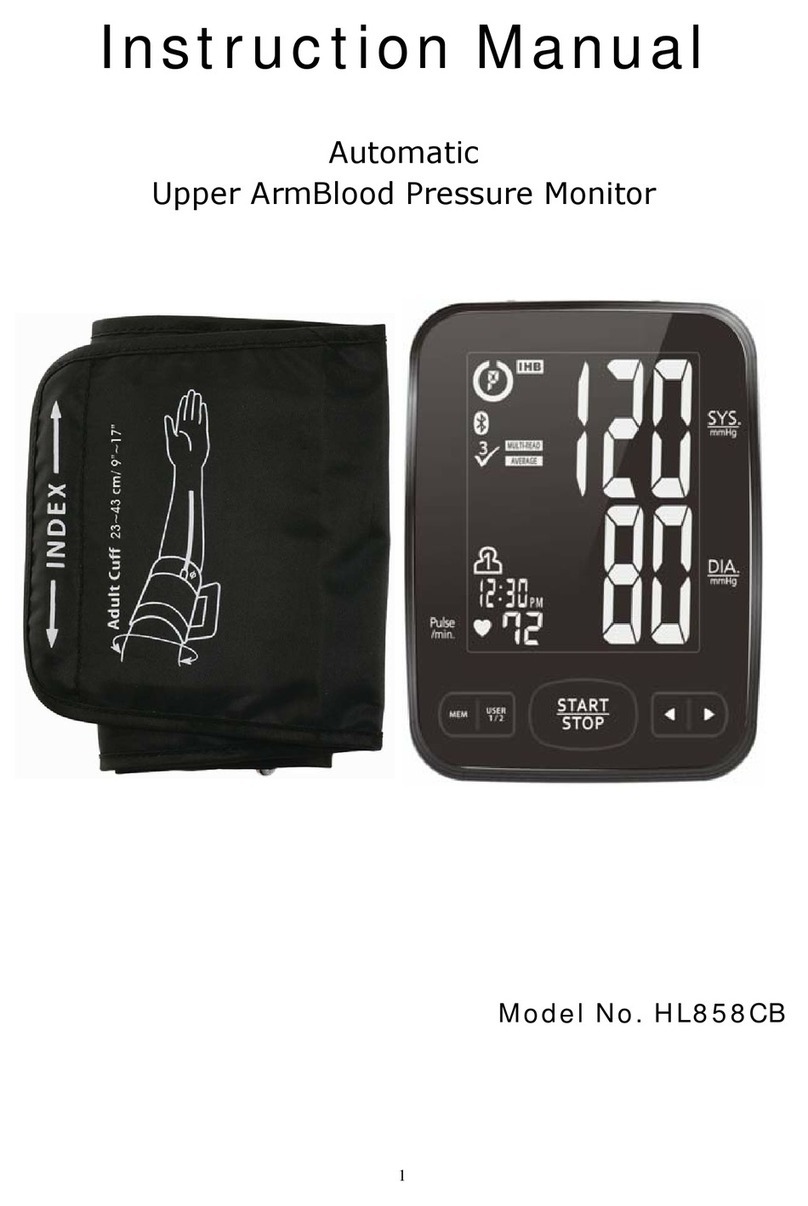
Health & Life
Health & Life HL858CB User manual
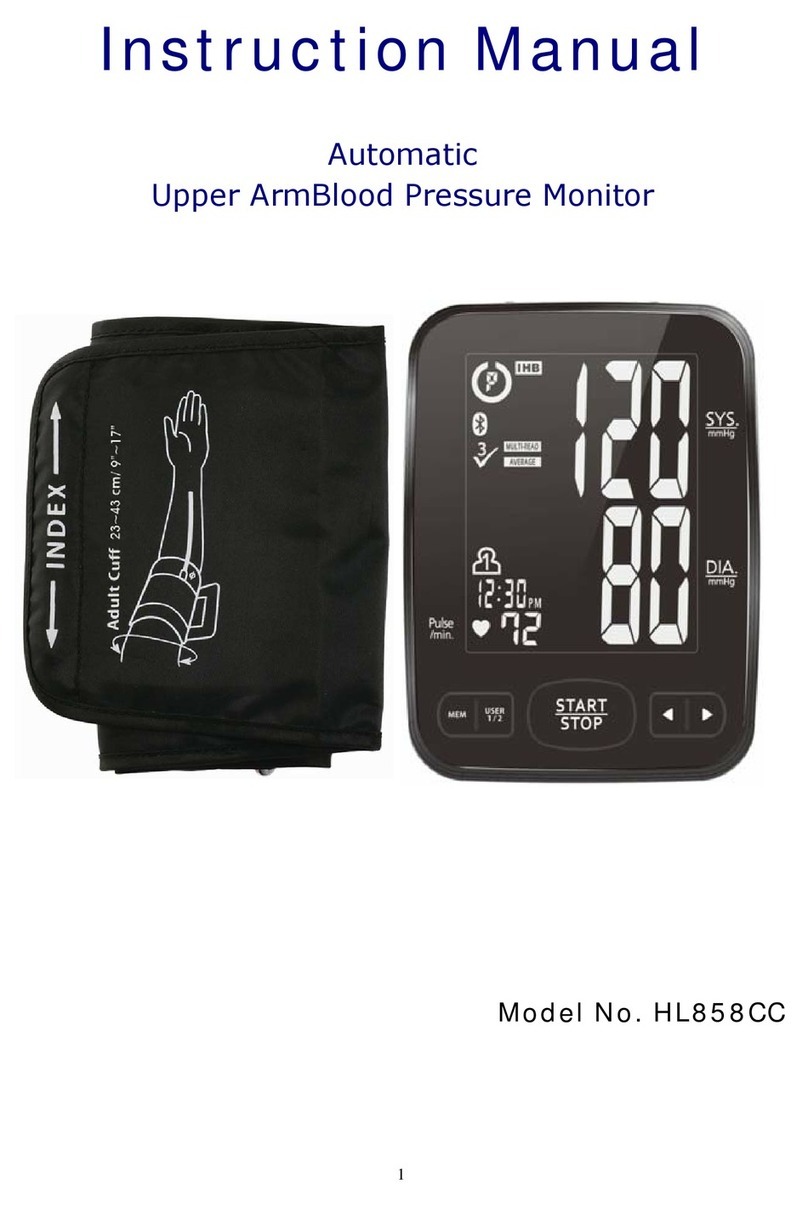
Health & Life
Health & Life HL858CC User manual

Health & Life
Health & Life HL858CB User manual

Health & Life
Health & Life HL158LD User manual
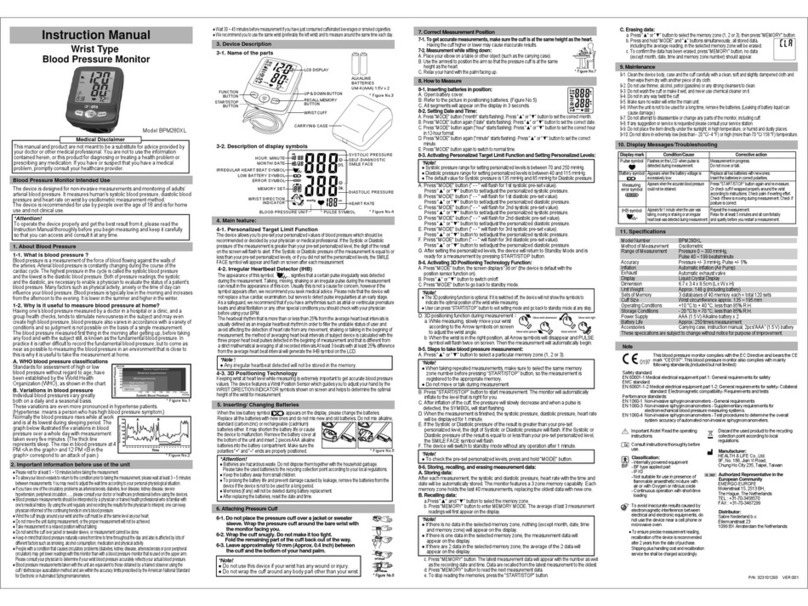
Health & Life
Health & Life BPM280XL User manual
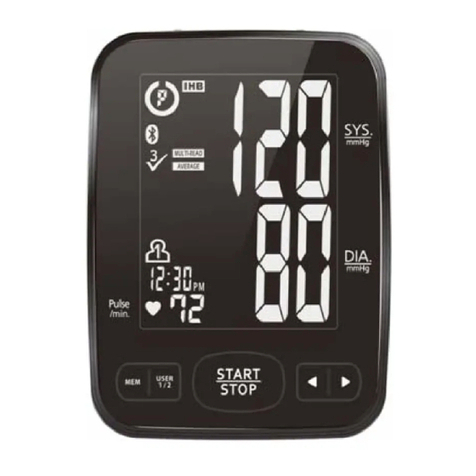
Health & Life
Health & Life HL858CC User manual

Health & Life
Health & Life HL858DC User manual

Health & Life
Health & Life HL158AU-BD User manual



